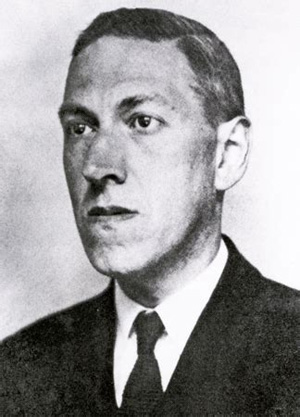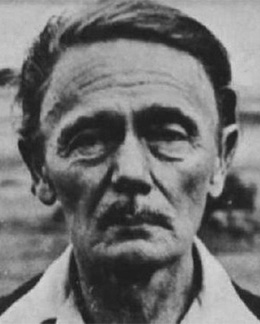 |
The Family Tree of the Gods |
 |
So fertile were the imaginations of the Old Gentleman from Providence and the Bard of Auburn that even their casual epistles sometimes make significant contributions to the lore of the Mythos. While these effusions have a playful and even humorous tone, they also maintain consistency with the published "official" stories and fill in background in interesting ways. The most noteworthy examples are probably H.P. Lovecraft and Clark Ashton Smith's family trees of their gods.
HPL's contribution was presented as a confession of his own blighted ancestry. In a letter to James F. Morton, dated April 27, 1933
This family tree places the blind idiot god Azathoth at the top of the pantheon, which is unsurprising since HPL elsewhere refers to him as the Lord of All, and depicts him as the source "Whence flow the aimless waves whose chance combining / Gives each frail cosmos its eternal law."
Beneath Azathoth we find Nyarlathotep, described here as "The ancient patrician gens Viburnia of Haec RESPVBLICA.ROMANA;" that is, the founder of the noble family named Viburnia in ancient Rome. The thought of the Crawling Chaos cavorting around in a toga is certainly quaint, and might explain much about the depravities of the Roman ruling class.
Also near the top we find "The Nameless Mist" and "Darkness," both of which were apparently too formless and vague to play any role in HPL's stories. But the next generation brings us to two of the heavy hitters in the Mythos: Yog-Sothoth and Shub-Niggurath, followed by their monosyllabic offspring, Nug and Yeb. The latter two were worshipped in both K'n-yan and Mu, and in Out of the Aeons (online text), HPL seems to imply that they are sons of Shub-Niggurath. The family tree confirms that they are indeed Shub-Niggurath's offspring, whereas it is Aeons that informs us that they are male.
Meanwhile, Lovecraft and Zealia Bishop's story The Mound (online text) shines an unexpected sidelight on the union of Yog-Sothoth and Shub-Niggurath, for we learn there that Shub-Niggurath was the wife of the "Not-to-Be-Named One." Sure enough, Yog-Sothoth is not mentioned by name in that story, and we are left to conclude that the Old Ones of K'n-yan had a taboo against mentioning Yog-Sothoth by name; though we can only speculate whether this convention arose from terror, awe, or loathing.
The next generation brings us to Cthulhu (offspring of Nug) and Tsathoggua (offspring of Yeb), providing quite a different parentage for both than we shall see in Smith's chart.
Yogash the Ghoul may be the same as Yogash the Black, who is briefly mentioned in The Dream Quest of Unknown Kadath (online text) as a slave who remains invisible so as not to disturb Randolph Carter. There appears to be no information available about the remaining names in the chart, except that they are all ancestors of Lovecraft or Smith.
Of course, Clark Ashton Smith also provided his own take on the geneology of the Elder Gods, in a pair of 1934 letters [2] to Robert H. Barlow, who seems to have been pestering him with questions.
Smith's chart is chiefly concerned with Tsathoggua and his close relations. Once again, Azathoth appears at the top of the chart, but so does Ycnagnnisssz, described as a "fissionary being from the dark star Zoth." It is conceivable that Ycnagnnisssz was literally spawned by the dark star Zoth, though one doesn't typically think of stars as giving birth to sentient beings. Alternatively, Ycnagnnisssz may have been spawned near Zoth from some parent that is not specified.
Smith remarks that "Azathoth, the primal nuclear chaos, reproduced of course only by fission; but its progeny, entering various outer planets, often took on attributes of androgynism or bisexuality. The androgynes, curiously, required no coadjutancy in the production of offspring; but their children were commonly unisexual, male or female . . . Thus you will note a trend toward biological complexity."
In this account, Tulu (Cthulhu) is listed as an offspring of Cxaxukluth, rather than Nug, as in Lovecraft's chart; whereas Tsathoggua is listed as the offspring of Ghizguth and Zstylzhemgni, rather than Yeb. Thus, although the two charts overlap only slightly (having just three names in common), they are still profoundly inconsistent.
However, some disclaimers are in order. For Smith states "Ech-Pi-El, I am sure, can furnish much fuller data concerning the genesis of Tulu (Cthulhu) than I am able to offer. It would seem, from the rather oblique references of Pnom, that Tulu was a cousin of Hzioulquoigmnzhah, but was somewhat closer to the Azathothian archetype than Hzioulquoigmnzhah." This statement implies that Smith's sources for Cthulhu's genealogy are incomplete or unclear. Also, he refers to Cthulhu and Hzioulquoigmnzhah as cousins, whereas the chart appears to portray them as siblings. Clearly, the chart sometimes skips over intervening generations. Later, Smith states "The immediate parent of Cthulhu and his race (child of Nug) was Ptmâk." With this revision, it is conceivable that Cxaxukluth was an ancestor of Nug, who fathered Ptmâk, who in turn engendered Cthulhu. The reference to Nug brings us within shouting distance of Lovecraft's genealogy for Cthulhu.
There are many difficulties in interpreting both Lovecraft and Smith's charts. To begin with, neither chart appears to be complete. For example, Lovecraft's chart shows only male ancestors for the most part. That chart also uses multiple slanted lines between some characters, such as between P. Viburnius Marco and Viburnia, which seem to imply a large number of generations of less noteworthy characters have been omitted. Lastly, when it comes to the elder beings near the top of the chart, we cannot assume that their forms of reproduction resemble anything in terrene biology; and even on our own planet, living things procreate and/or swap genetic material in a startling variety of ways.
The question arises of whether anything can be done to reconcile these two genealogical scriptures, passed down to us by two of our most esteemed prophets: Ech-Pi-El and Klarkash-Ton. Of course, any such attempt is fraught with peril, not least because, as all the records show, madness is the usual fruit of learning too much about the Elder Ones. Is it "some imp of the perverse—or some sardonic pull from dark, hidden sources—" that impels us to the attempt? Perhaps, but as the sequel will show, we were unable to resist.
The guiding principle for such an interpretation should, I suggest, be as follows: each author should be treated as the more authoritative source for the deity that they personally are descended from. Thus, in matters Cthulhuvian, Lovecraft's views take precedence; whereas in matters Tsathogguish, Smith's views must be taken as prime. Bearing this guideline in mind, the following combined chart suggests itself as at least a possibility:
The first compromise in this chart regards Ycnagnnisssz, who here is explicitly listed as a spawn of Azathoth, though Smith did not specify Ycnagnnisssz's forbears. However, this is probably not too great a leap, since Lovecraft presents Azathoth as the source of all cosmoses, and Smith refers to Azathoth as "the primal nuclear chaos." Besides this, Smith describes Ycnagnnisssz as a "fissionary being," which means that it is close to the Azathothian prototype and thus probably not separated from Azathoth by many generations.
Regarding Cthulhu, we follow Lovecraft's lead by making him a descendant of Nug; but willingly accept Smith's view that Ptmâk is Cthulhu's immediate parent. It remains true, as Smith says, that Cthulhu is a cousin of Hzioulquoigmnzhah, but only in the general sense that both are among the first few generations of descendants from Azathoth.
Regarding Tsathoggua, Smith's letters supply a rather concrete domestic history that is difficult to ignore. Smith explains that Cxaxukluth brought its offspring Hzioulquoigmnzhah and Ghizguth to Yuggoth, along with the latter's wife Zstylzhemgni and their infant Tsathoggua. Accordingly, Smith's view on these matters is retained, without alteration, in the combined chart.
The question remains, how did Lovecraft come to portray Tsathoggua as a descendant of Yeb? The question presents some curious possibilities, such as that Tsathoggua had three parents, comprising Yeb, Ghizguth, and Zstylzhemgni. While we can hardly exclude such a combination, it remains odd that Smith did not mention it, since he was hardly squeamish about such matters. On the whole, we find it more plausible that Tsathoggua married into the line of Yeb's descendants, and so became himself one of the ancestors of the later beings in Yeb's line. This alliance is easily enough explained, once you notice that Smith does not specify any ancestors for Tsathoggua's wife Shathak (aka Chushax or Zishaik). If Shathak is descended from Yeb, then Tsathoggua's marriage neatly joins him to Yeb's lineage.
It is less clear how the descendants of Tsathoggua and Shathak are related among themselves. Smith supplies a line of descendants beginning with Tsathoggua's child Zvilpogghua. Lovecraft's chart supplies a different line of descendants from Tsathoggua, beginning with Yabou. Lovecraft also provides Tsathoggua with a child called Ossadagowah in the fragment Of Evill Sorceries done in New England, of Daemons in No Humane Shape (online text). It's impossible to say if Ossadagowah is a sibling of Yabou or an intermediate ancestor. For simplicity, I have inserted Ossadagowah into the chart between Tsathoggua and Yabou.
For reasons of space, the chart omits the union of Nyarlathotep and Yhoundeh, as well as the latter's parent, Zyhumë, though Smith mentions these in his text. Also omitted are those two failed spawn of Yog-Sothoth via Lavinia Whateley: the prodigious Wilbur Whateley and his older brother, the "Dunwich Horror." One suspects that, like the mighty Zeus, Yog-Sothoth and Nyarlathotep probably spawned many offspring with varied consorts.
Sadly, several of the major Elder Ones were omitted by both Lovecraft and Smith. One would give much to learn how beings such as Dagon, Ghatanothoa, Rhan-Tegoth, and Gol-goroth fit in to this picture. Morphological considerations suggest that there must be a relationship between K'baa the Serpent and Yig, the Serpent People, the Little People, and Marceline Bedard. However, all such speculations are too nebulous to be pursued fruitfully. This combined chart may be the best that we can do, until other sources are brought to light from antediluvian and possibly prehuman times.
Footnotes
1. H. P. Lovecraft, Selected Letters IV (1932-1934). Sauk City, WI: Arkham House Publishers, 1976. Page 183.
2. Clark Ashton Smith, letters to Robert H. Barlow, dated June 16, 1934 and September 10, 1934. Portions were republished in a combined form as "From the Parchments of Pnom," in Clark Ashton Smith (editor Robert M. Price), The Tsathoggua Cycle, Chaosium Inc., 2005. A shorter version, using only material from the first letter, was originally published in The Acolyte, Summer 1934, and can be found online at The Family Tree of the Gods by Clark Ashton Smith (eldritchdark.com, accessed 09/11/22). Actually, it is unclear to me whether the chart was originally drawn by Smith himself, or whether it was drafted by Acolyte editor Francis Towner Laney, based on statements in Smith's letter. The complete versions of the two letters are available at Letter to Robert Barlow From Clark Ashton Smith on 16 June 1934 (eldritchdark.com) and Letter to Robert Barlow From Clark Ashton Smith on 10 September 1934 (eldritchdark.com).
Return to Cthulhu Files home page
Send comments to jfm.baharna@gmail.com.
Version 2, 02/23/2024: Updated with information on Ossadagowah.
© Copyright 2022-2024 by Joseph Morales.